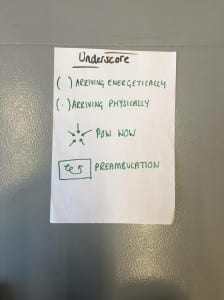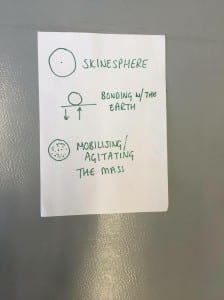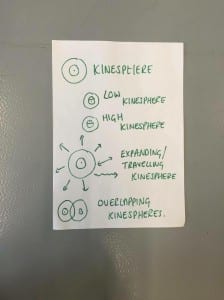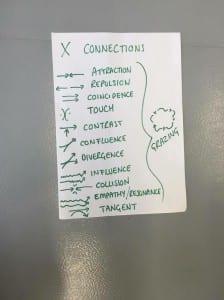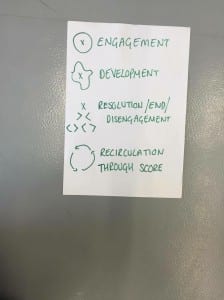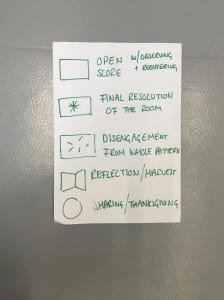Nancy Stark-Smith’s Underscore – Reading and Task
We started this task by reading about Nancy Stark-Smith’s Score in groups, then had to create a score using some of her underscores, as well as thinking about the RSVP cycle from the previous week and time, dynamics, influence of movement in space, spatial relationships and combatting habitual movement. Stark-Smith explains that the underscore is “a framework for practicing and researching dance improvisation” and that it “guides dancers through a series of “changing states.”” The underscore we were looking at looked like this:
Last week’s reading about the RSVP cycle was useful when creating this score as it gave me something to think about. We also needed to think about time, dynamics, influence of movement in space, spatial relationships and combatting habitual movement.
After looking at these for ideas we began to discuss and create our score as a group. First we discussed splitting the room into 3 (half and two quarters), as there were 3 other groups in the room and they would work in each section within these groups. The purpose of our score was finding the connection between person, time and object while challenging habitual movements.
Firstly we liked the idea of attraction and repulsion from the underscore and thought it would be interesting to see how two different groups handled this so we gave one quarter attraction and the other quarter repulsion to work with.
The group working with attraction had a completely open score to interpret and during observation we could see that the tendencies of this group was to copy or compliment whoever they were attracted to within the other group.
The group working with repulsion also had other instructions to follow. They were only allowed to work in a medium to high kineosphere and they were given different imageries to think about throughout the time they spent in the section. We chose the high kineosphere because over the semester it has become apparent then when people improvise they spend a lot of time working on the lower kineosphere and use it as a comfort zone so we wanted to challenge them even more. The imageries we used were quite adventurous such as embodying a worm as this is typically one that would immediately draw you to the floor.
The last section of the room we set to work with a ball to bring in Stark-Smith’s idea of connection and touch; and as well as imagery and the instruction of no hands to be used when passing the ball around the group. When observing this group I found
Each group would spend around 2.5 to 3 minutes in one section before rotating round to participate in another section and all groups would have the chance to work in each section once. We also set one instruction that was to be followed by all groups. For the first minute spent in each section the participants must feel the time and hold 6 counts of stillness when they thought the first minute had passed. Looking for this in the task you could tell that the groups were either focusing on their separate instructions or trying to feel the time for 1 minute.
At the end of the score we asked the groups some feedback questions and they responded really well to our questions and made some interesting observations of their own movement. Most people agreed that the ball was a distraction from improvisation and found they were focusing on moving the ball as opposed to moving their bodies too. Whereas, others argued that it helped them explore movement on a different level to what they’re used to.
If I was to recreate a score, I would look at ways of simplifying the score as this proved to be quite a difficult score for the groups to follow.
Bibliography
Stark-Smith, N. (2008) Caught Falling: the confluence of contact improvisation. Northampton, MA Contact Editions.
